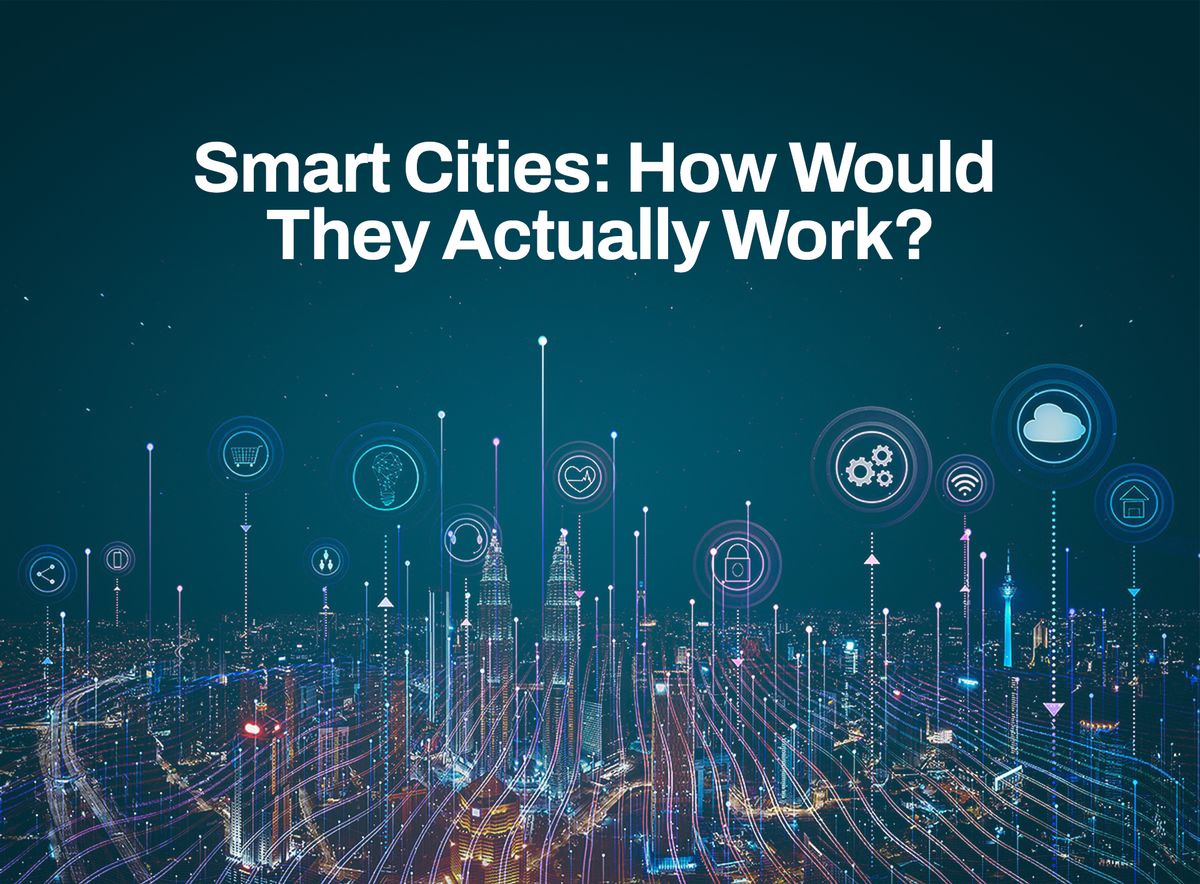Smart Cities: How Would They Actually Work?
How do smart cities function? Here is how AI, IoT, and blockchain are shaping the cities of the future.

Table of Contents
- What Is a Smart City?
- How Do Smart Cities Work?
- The Technology Behind Smart Cities
- Benefits of Smart Cities
- Challenges of Building Smart Cities
- Ten Examples of Smart Cities in the World
- What Will Smart Cities Look Like in the Future?
- Wrapping Up
- FAQs About Smart Cities
We know about smartphones, smartwatches, smart cars, smart locks, smart glasses, and even smart houses. But have you heard about smart cities? Most likely! You must have come across news of projects on smart cities and their potential to use technology to solve problems and improve the quality of life for residents.
As technologies become more integrated into everyday life, smart cities have become a growing trend. But beyond these possibilities, what exactly is a smart city, and how does it function?
In this article, we'll explore the concept of smart cities, how they work, and what the future holds for these advanced urban centres.
What is a Smart City?
A smart city is an urban area that uses technology to improve its functions, making life easier for its residents. This is a city where everything, from traffic lights to energy use, is managed through smart technology like sensors, cameras, and the internet. These cities use data to solve problems such as traffic jams, air pollution, and waste management. For example, Barcelona, one of the top smart cities in the world, uses sensors to monitor traffic and parking, reducing congestion.
One of the key parts of smart cities is the Internet of Things (IoT), also known as “smart objects”, which consists of a network of physical devices, such as vehicles and appliances, connected to collect and share data. A smart city IoT system can help efficiently manage electricity, water, and public transport, saving time and resources.
Smart cities focus on improving sustainability by reducing energy use and reducing pollution. In fact, many smart city developers are working to create cities that rely more on renewable energy.
If you would like to watch movies that portray how smart cities cities work, here’s a short list:
1. Cities of the Future
2. Fifth Element
3. Appleseed
4. Start Trek
5. Elysium
6. Cloud Atlas
7. Tomorrowland
8. Gattaca
9. Valerian and the City of a Thousand Planets
10. Total Recall
How Do Smart Cities Work?
Smart cities use advanced technology, data, and the Internet of Things (IoT) to create more efficient, sustainable, and livable urban environments. At their central point, smart cities rely on a network of interconnected devices—like sensors, cameras, and other gadgets—to collect and share real-time data.
This data helps city officials make better decisions about resources, infrastructure, and public services. For instance, smart traffic lights can adjust to real-time traffic conditions, reducing congestion and saving commuters time. According to McKinsey, smart city solutions can reduce commute times by up to 20%, making daily life easier for residents.
Also, smart cities integrate energy-efficient systems to reduce their environmental impact. Buildings in smart cities are often equipped with smart meters, which monitor and control electricity usage, helping reduce energy waste. According to the International Energy Agency (IEA), smart energy systems can cut a city’s carbon emissions by up to 15%. The use of renewable energy, like solar power, is also common in the development of smart cities, as seen in projects like Akon Smart City in Senegal and Eko Atlantic in Nigeria. Both aim to create eco-friendly, tech-driven urban spaces.
Public safety is another important feature of smart cities. By using connected cameras and sensors, city officials can respond to emergencies faster, improve crime detection, and even predict potential incidents. Barcelona, one of the top smart cities, uses these technologies to ensure a safer environment for its residents. This type of real-time data sharing also enhances other areas, like waste management and public transportation. For example, smart bins can alert waste collectors when full, improving collection schedules and keeping the city cleaner.
With about 500 smart city projects already in progress worldwide, cities like Singapore, Barcelona, and Tokyo are leading the charge in creating more sustainable, tech-friendly urban environments.
The Technology Behind Smart Cities
1. Internet of Things (IoT):
IoT connects everyday devices to the internet, allowing them to send and receive data. In smart cities, IoT is used for everything from managing traffic lights to monitoring air quality. For instance, smart streetlights can adjust their brightness based on the amount of ambient light or the presence of pedestrians, saving energy and improving safety.
2. Data Analytics:
Smart cities generate enormous amounts of data from various sources, like sensors and cameras. This data is analysed to make better decisions and improve city services. For example, data on traffic patterns helps optimise traffic flow and reduce congestion.
3. Artificial Intelligence (AI):
AI processes data to predict and manage city functions more efficiently. AI algorithms can analyse data patterns to forecast public transport demand or predict infrastructure maintenance needs. For instance, AI could be used to manage waste collection, ensuring bins are emptied only when full, reducing unnecessary trips and saving resources.
4. Smart Infrastructure:
This includes advanced systems and materials used in city planning and construction. Examples are smart grids for electricity, which manage energy distribution more efficiently, and smart buildings that use sensors to control heating, cooling, and lighting. These technologies enhance comfort and contribute to building sustainable smart cities.
enefits of Smart Cities
1. Improved Efficiency and Convenience:
Smart cities use technology to streamline services and make daily tasks easier. For example, smart traffic management systems can reduce congestion by adjusting traffic lights based on real-time traffic conditions. This means less time spent in traffic and more efficient commutes. In smart cities, public transport systems are often integrated with apps that provide real-time updates on schedules and delays, making travel more predictable and convenient.
2. Enhanced Public Safety:
Smart cities employ various technologies to enhance public safety. Surveillance cameras with facial recognition, integrated emergency response systems, and smart street lighting that adjusts based on activity can help reduce crime rates and respond more quickly to emergencies.
3. Environmental Sustainability:
One of the most significant benefits of smart cities is their focus on environmental sustainability. Smart grids optimise energy use and reduce waste by adjusting energy distribution based on real-time demand. Smart water management systems can detect leaks and ensure efficient water use, which is crucial for conserving resources.
4. Cost Savings:
By improving efficiency and reducing waste, smart cities can lead to significant cost savings. For instance, smart meters for electricity, gas, and water help monitor consumption accurately and identify areas where savings can be made. This helps residents save money and reduces the overall cost of running city services.
5. Better Quality of Life:
Smart cities aim to enhance the quality of life for their residents. This includes cleaner air and water, better service access, and improved public spaces. Smart city technologies can create healthier environments by monitoring pollution levels and managing waste more effectively. For instance, the “smart city” concept includes features like smart parks and recreational areas that adapt to user needs, providing a better living experience.
6. Economic Growth:
The development of smart cities can spur economic growth by attracting businesses and creating jobs. Companies are often drawn to smart cities because of their modern infrastructure and innovative technologies. Smart city projects can also stimulate local economies through investment in technology and development.
Challenges of Building Smart Cities
1. Funding and Investment:
Developing the infrastructure for a smart city, like installing sensors and data networks, can be extremely expensive, and securing sufficient investment can take time and effort. Governments and private investors need to collaborate to fund these projects, and there is always a risk of financial overruns.
2. Technology Integration:
Smart cities rely on various technologies, such as the Internet of Things (IoT), artificial intelligence, and data analytics, to function effectively. Integrating these technologies seamlessly is crucial but complex. Each piece of technology must work together smoothly, which requires careful planning and coordination.
3. Data Privacy and Security:
With smart cities collecting vast amounts of data from sensors and devices, protecting this information from cyber threats is essential. Smart city developers need to implement strong security measures to safeguard personal data, which is becoming increasingly challenging as technology advances.
4. Sustainability:
While smart cities aim to be more efficient and environmentally friendly, achieving true sustainable smart city status involves careful management of resources and energy. Developers must prioritise the key goal of ensuring that smart city technologies do not contribute to environmental problems.
5. Social Equity:
If only certain areas benefit from the latest technologies, smart cities might widen the gap between different socio-economic groups. Efforts must be made to ensure that all residents, not just those in affluent areas, enjoy the benefits of a smart city.
Ten Examples of Smart Cities in the World
1. Singapore:
Singapore’s Smart Nation initiative, which is often referred to as the leader of the smart city pack, started in 2014 and has continued to innovate since then. With contactless payment systems widely used in this city, it efficiently manages the movement and payments of its 7.5 million passengers daily. The city also introduced digital health systems, including video consultations and wearable IoT devices for health monitoring. Singapore is developing a new eco-smart city in Tengah, which will be entirely vehicle-free and feature pedestrian- and cyclist-friendly zones.
2. Helsinki, Finland:
Helsinki is on a mission to become carbon-neutral by 2035. Since 1990, it has cut emissions by 27% and aims to reduce traffic emissions by 69% by transitioning to electric buses and expanding electric car charging stations. The city is also focusing on energy-efficient building renovations to cut emissions by up to 80% and increase renewable energy use.
3. Zurich, Switzerland:
Zurich began its smart city journey with adaptive streetlights that save up to 70% in energy. The city has since expanded to include smart streetlights that collect environmental data and monitor traffic. Zurich’s smart building management system effectively integrates heating, electricity, and cooling to enhance energy efficiency.
4. Oslo, Norway:
Oslo is pushing towards an all-electric vehicle fleet by 2025. The city provides incentives such as free parking and use of bus lanes for electric cars. It is also working on zero-emission construction sites and retrofitting buildings to improve waste management and green energy use, aiming for carbon neutrality by 2050.
5. Amsterdam, The Netherlands:
Amsterdam’s smart city efforts began in 2009 and now encompass over 170 operations. Innovations include solar-powered bus stops and floating villages. The city has also implemented energy-efficient measures in thousands of homes and businesses, such as smart meters and LED lights.
6. New York, United States:
New York’s smart city pilot programme involves deploying smart sensors to efficiently manage services like waste collection. The city has introduced smart hubs with contactless technology and WiFi, and it supports car-sharing services to reduce emissions and traffic congestion. An annual contest encourages local developers to create apps using city data.
7. Seoul, South Korea:
Seoul is home to Songdo, the world’s first smart city. The city collects and analyses data on traffic and air quality through sensors and CCTV. It focuses on aiding senior citizens living alone with safety initiatives and is exploring AI for crime detection. Seoul is also a pioneer in 5G technology applications.
8. Akon City, Senegal:
Planned by singer Akon, Akon City aims to be a high-tech, eco-friendly city powered by renewable energy, including solar power. Scheduled for completion in phases, the city will feature a technology hub, shopping areas, and a music studio, inspired by the movie "Black Panther." It promises to stimulate the local economy and create jobs.
9. Eko Atlantic, Nigeria:
Eko Atlantic is a planned city built on land reclaimed from the Atlantic Ocean. Designed to combat coastal erosion, the city will house 250,000 residents and accommodate 150,000 daily commuters. It aims to provide a modern solution to land loss and space shortages in Lagos.
10. Barcelona, Spain:
Barcelona was an early adopter of smart city technologies, starting with extensive sensor networks. The city uses these technologies to monitor transport, energy usage, and air quality. Recently, Barcelona has focused on using digital tools to engage citizens directly, promoting open governance and data sovereignty through platforms like Decidim.
What Will Smart Cities Look Like in the Future?
Looking ahead, smart cities are set to become even more advanced and integrated into our daily lives. In the future, smart cities will use the latest technology to make urban living more efficient, sustainable, and comfortable. For example, we can expect to see even more widespread use of Internet of Things (IoT) devices, which will help manage everything from traffic flow to energy use.
Buildings will be equipped with sensors that automatically adjust lighting, heating, and cooling based on occupancy and weather conditions. Public transportation will be more connected, with real-time updates and autonomous vehicles reducing wait times and improving safety.
Sustainable smart cities will also focus heavily on green energy. Solar panels, wind turbines, and other renewable energy sources will become common sights, helping cities to reduce their carbon footprint.
Smart grids will optimise energy distribution, ensuring that power is used efficiently and reducing waste. Cities like Akon City in Senegal and Eko Atlantic in Nigeria are already planning these kinds of innovations, aiming to blend cutting-edge technology with eco-friendly practices.
Additionally, smart cities of the future will prioritise inclusivity. The concept of "smart cities for all" will ensure that advancements benefit everyone, not just the tech-savvy or affluent.
Technologies will be designed to improve accessibility and support diverse needs, making urban living more equitable. Barcelona's approach to involving citizens in decision-making through digital platforms is an example of this trend.
Wrapping Up
One thing we know for sure is that smart city developers are going to push for more advancements until smart cities become as common as water.
Concerning the possibility of advancements for Akon City and Eko Atlantic, which are among the first in Africa, Akon revealed in a recent interview that the first phase of Akon City will open in 2026.
The developers of Eko Atlantic are also launching more initiatives to expand the project.
Do you also believe that a functional and sustainable smart city is attainable in Africa?
FAQs
Q1. What is a smart city?
A smart city uses technology to improve the efficiency of services and infrastructure.
Q2. What technology do smart cities use?
Smart cities use IoT, AI, big data, and smart grids.
Q3. What makes a city smart?
A smart city uses data and technology to solve urban challenges and improve quality of life.
Q4. What is the benefit of a smart city?
Smart cities are more efficient and sustainable, offering residents a better quality of life.
Q5. How many smart cities are there in the world?
There are over 1,000 smart city projects worldwide.
Q6. What’s the first smart city in the world?
The first smart city is widely considered to be Singapore due to its early adoption of smart technology.
Q7. What is the future of smart cities?
The future looks promising, with more cities adopting smart technologies to become sustainable and efficient.
Q8. How does the Internet of Things (IoT) impact smart cities?
IoT enables smart cities to collect data in real-time, improving decision-making and resource management.
Q9. What are the challenges in building smart cities?
High costs, data security, and inclusivity are some of the major challenges.
Q10. How can we build a smart city?
Building a smart city requires investment in technology, infrastructure, and planning that focuses on sustainability and inclusivity.
Disclaimer: This article was written to provide guidance and understanding. It is not an exhaustive article and should not be taken as financial advice. Obiex will not be held liable for your investment decisions.




